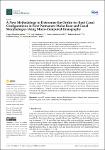A New Methodology to Determine the Orifice for Root Canal Configurations in First Permanent Molar Root and Canal Morphologies Using Micro-Computed Tomography
| dc.contributor.author | Jonker, CH | |
| dc.contributor.author | Lambourn, G | |
| dc.contributor.author | Oettlé, AC | |
| dc.contributor.author | Foschi, F | |
| dc.contributor.author | Theye, C | |
| dc.contributor.author | L’Abbé, EN | |
| dc.date.accessioned | 2024-03-18T11:51:13Z | |
| dc.date.available | 2024-03-18T11:51:13Z | |
| dc.date.issued | 2023-12-22 | |
| dc.identifier.issn | 2077-0383 | |
| dc.identifier.issn | 2077-0383 | |
| dc.identifier.other | ARTN 71 | |
| dc.identifier.uri | https://pearl.plymouth.ac.uk/handle/10026.1/22202 | |
| dc.description.abstract |
<jats:p>Background: The distinction between where the pulp chamber ends and the root canal system begins is poorly defined within the existing literature. Methods: This paper aimed to describe a range of accurate methods to define the transition from pulp chamber to root canal in different first molar root morphologies using micro-focus computed tomography (micro-CT). Methods: The sample consisted of 86 mandibular and 101 maxillary first molars from the skeletal collections housed in the Department of Anatomy and Histology of the Sefako Makgatho Health Sciences University and the Pretoria Bone Collection. A stepwise approach using the cemento–enamel junction (CEJ) and dedicated landmarks was followed to create an automated cross-sectional slice. Results: Transition from pulp chamber to root canal could be accurately determined on maxillary and mandibular teeth. The occurrence of two separate roots in mandibular molars was 97.7%, with the remaining 2.3% having an additional disto-lingual root, with no mandibular molars displaying fused roots. In the maxillary molars, 92.1% had three separate roots and 7.9% displayed root fusion. Within this group, one tooth displayed a C-shaped root canal configuration and one a mesotaurodont-type morphology. Conclusion: The suggested methodology to determine orifice location was found to be appropriate in all morphological types.</jats:p> | |
| dc.format.extent | 71-71 | |
| dc.format.medium | Electronic | |
| dc.language | en | |
| dc.publisher | MDPI | |
| dc.subject | micro-CT | |
| dc.subject | cemento-enamel junction | |
| dc.subject | Radix Entomolaris | |
| dc.subject | C-shaped canal | |
| dc.subject | mesotaurodont | |
| dc.subject | fused roots | |
| dc.subject | pulp floor | |
| dc.subject | orifice | |
| dc.subject | landmarks | |
| dc.subject | root morphologies | |
| dc.title | A New Methodology to Determine the Orifice for Root Canal Configurations in First Permanent Molar Root and Canal Morphologies Using Micro-Computed Tomography | |
| dc.type | journal-article | |
| dc.type | Article | |
| plymouth.author-url | https://www.ncbi.nlm.nih.gov/pubmed/38202078 | |
| plymouth.issue | 1 | |
| plymouth.volume | 13 | |
| plymouth.publication-status | Published online | |
| plymouth.journal | Journal of Clinical Medicine | |
| dc.identifier.doi | 10.3390/jcm13010071 | |
| plymouth.organisational-group | |Plymouth | |
| plymouth.organisational-group | |Plymouth|Faculty of Health | |
| plymouth.organisational-group | |Plymouth|REF 2021 Researchers by UoA | |
| plymouth.organisational-group | |Plymouth|Users by role | |
| plymouth.organisational-group | |Plymouth|Users by role|Academics | |
| plymouth.organisational-group | |Plymouth|REF 2021 Researchers by UoA|UoA03 Allied Health Professions, Dentistry, Nursing and Pharmacy | |
| plymouth.organisational-group | |Plymouth|Faculty of Health|Peninsula Dental School | |
| plymouth.organisational-group | |Plymouth|REF 2029 Researchers by UoA | |
| plymouth.organisational-group | |Plymouth|REF 2029 Researchers by UoA|UoA03 Allied Health Professions, Dentistry, Nursing and Pharmacy | |
| dc.publisher.place | Switzerland | |
| dcterms.dateAccepted | 2023-12-18 | |
| dc.date.updated | 2024-03-18T11:51:11Z | |
| dc.rights.embargodate | 2024-3-19 | |
| dc.identifier.eissn | 2077-0383 | |
| rioxxterms.versionofrecord | 10.3390/jcm13010071 |


